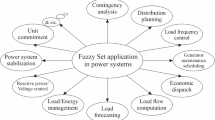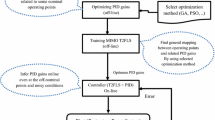Abstract
Expanded use of non-direct loads and deficiency occasion on the force framework has developed decrease in the nature of intensity gave to the clients. It is essential to perceive and recognize the force quality (PQ) aggravations in the conveyance framework. In order to perceive and recognize the PQ unsettling influences, it requires the advancement of profoundly assurance plans. This paper presents an ideal insurance plot for PQ occasions expectation and characterization in the circulation framework. The proposed insurance conspire is the consolidated presentation of both the gravity search algorithm (GSA) and fuzzy framework. Here, GSA is used in two stages with the target capacity of expectation and grouping of the PQ occasions. The standard fuzzy first stage is used for perceiving the sound or unfortunate state of the framework under different circumstances. Fluffy is used for see the framework signal solid or undesirable condition under various conditions. In second stage, fluffy plays out the characterization of the unfortunate signs to perceive the privilege PQ occasion for affirmation. Here, the second stage fuzzy learning technique is improved by using the SSO dependent on the base mistake target work. These proposed techniques play an evaluation methodology to guarantee the framework and organize the ideal PQ occasion which happens in the dispersion framework. By then, the recomended work is carryout in MATLAB/Simulink software, and the exhibitions of the recomended framework are contrasted and distinctive existing strategies like MUSIC-ANN, GA-ANN. Examination result exhibits prevalence of GSA-fuzzy method, affirm its capability of PQ occasions gauge and course of action.
Access this chapter
Tax calculation will be finalised at checkout
Purchases are for personal use only
Similar content being viewed by others
References
Smith Jayasree T, Devaraj D, Sukanesh R (2010) Power quality disturbance classification using Hilbert transform and RBF networks. Neurocomputing 73(7–9):1451–1456
Mishra S, Bhende C, Panigrahi B (2008) Detection and classification of power quality disturbances using S-Transform and probabilistic neural network. IEEE Trans Power Deliv 23(1):280–287
Singh U, Singh S (2017) Detection and classification of power quality disturbances based on time–frequency-scale transform. IET Sci Measurem Technol 11(6):802–810
Erişti H, Demir Y (2010) A new algorithm for automatic classification of power quality events based on wavelet transform and SVM. Expert Syst Appl 37(6):4094–4102
Wang H, Wang P, Liu T (2017) Power quality disturbance classification using the s-transform and probabilistic neural network. Energies 10(1):107
Babu P, Dash P, Swain S, Sivanagaraju S (2013) A new fast discrete S-transform and decision tree for the classification and monitoring of power quality disturbance waveforms. Int Trans Electri Energy Syst 24(9):1279–1300
Biswal B, Mishra S (2014) Power signal disturbance identification and classification using a modified frequency slice wavelet transform. IET Gener Transm Distrib 8(2):353–362
Masoum M, Jamali S, Ghaffarzadeh N (2010) Detection and classification of power quality disturbances using discrete wavelet transform and wavelet networks. IET Sci Measurem Technol 4(4):193–205
Hooshmand R, Enshaee A (2010) Detection and classification of single and combined power quality disturbances using fuzzy systems oriented by particle swarm optimization algorithm. Electric Power Syst Res 80(12):1552–1561
Kanirajan P, Kumar V (2015) Wavelet-based power quality disturbances detection and classification using RBFNN and fuzzy logic. Int J Fuzzy Syst 17(4):623–634
Kapoor R, Gupta R (2011) Fuzzy lattice based technique for classification of power quality disturbances. European Trans Electri Power 22(8):1053–1064
Puliyadi Kubendran A, Loganathan A (2016) Detection and classification of complex power quality disturbances using S-transform amplitude matrix-based decision tree for different noise levels. Int Trans Electri Energy Syst 27(4):
Sridhar S, Rao K, Sukrutha Jade S (2016) Detection and classification of power quality disturbances in the supply to ınduction motor using wavelet transform and neural networks. Balkan J Electri Comput Eng 4(1):37–45
Jashfar S, Esmaeili S, Zareian-Jahromi M, Rahmanian M (2013) Classification of power quality disturbances using S-transform and TT-transform based on the artificial neural network. Turkish J Electri Eng Comput Sci 21(6):1528–1538
Singh K (2015) Classification of power quality disturbances using wavelet transform and neural network. Int J Eng Res 4(5):423–1427
Sundaram P, Neela R (2016) Characterization and localization of power quality disturbances based on s-transform and fuzzy expert system. IOSR J Electri Electron Eng 11(4):42–53
Ahila R, Sadasivam V, Manimala K (2012) Particle swarm optimization-based feature selection and parameter optimization for power system disturbances classification. Appl Artif Intell 26(9):832–861
Liu Z, Cui Y, Li W (2015) Combined power quality disturbances recognition using wavelet packet entropies and s-transform. Entropy 17(8):5811–5828
Kapoor R, Saini M (2011) Hybrid demodulation concept and harmonic analysis for single/multiple power quality events detection and classification. Int J Electri Power Energy Syst 33(10):1608–1622
Morales-Velazquez L, Romero-Troncoso R, Herrera-Ruiz G, Morinigo-Sotelo D, Osornio-Rios R (2017) Smart sensor network for power quality monitoring in electrical installations. Measurement 103:133–142
Zhang S, Li P, Zhang L, Li H, Jiang W, Hu Y (2016) Modified S transform and ELM algorithms and their applications in power quality analysis. Neurocomputing 185:231–241
Kanirajan P, Suresh Kumar V (2015) Power quality disturbance detection and classification using wavelet and RBFNN. Appl Soft Comput 35:470–481
Rodriguez-Guerrero M, Carranza-Lopez-Padilla R, Osornio-Rios R, de J Romero-Troncoso R (2017) A novel methodology for modeling waveforms for power quality disturbance analysis. Electric Power Syst Res 143:14–24
Ahila R, Sadasivam V, Manimala K (2015) An integrated PSO for parameter determination and feature selection of ELM and its application in the classification of power system disturbances. Appl Soft Comput 32:23–37
Mariaraja P, Manigandan T, Thiruvenkadam S (2018) An expert system for distribution system reconfiguration through fuzzy logic and flower pollination algorithm. Measurem Control 51(9–10):371–382
Cai H, Li P, Su C, Cao J (2018) Double-layered nonlinear model predictive control based on Hammerstein-Wiener model with disturbance rejection. Measurem Control 51(7–8):260–275
Mouzakitis A (2013) Classification of fault diagnosis methods for control systems. Measurem Control 46(10):303–308
Karthikumar K, Senthil Kumar V, Karuppiah M (2019) A new protection scheme for pq events prediction and classification in distribution system: a sso-ann strategy. Measurement Control 52(5–6):449–461
Khokhar S, Mohd Zin A, Memon A, Mokhtar A (2017) A new optimal feature selection algorithm for classification of power quality disturbances using discrete wavelet transform and probabilistic neural network. Measurement 95:246–259
Manikandan M, Samantaray S, Kamwa I (2015) Detection and classification of power quality disturbances using sparse signal decomposition on hybrid dictionaries. IEEE Trans Instrument Measurem 64(10):27–38
Rostek K, Morytko Ł, Jankowska A (2015) Early detection and prediction of leaks in fluidized-bed boilers using artificial neural networks. Energy 89:914–923
Wang G, Hao J, Ma J, Huang L (2010) A new approach to intrusion detection using artificial neural networks and fuzzy clustering. Expert Syst Appl 37(9):225–6232
Samanta B, Al-Balushi K, Al-Araimi S (2003) Artificial neural networks and support vector machines with genetic algorithm for bearing fault detection. Eng Appl Artif Intell 16(7–8):657–665
Mirjalili S, Gandomi A, Mirjalili S, Saremi S, Faris H, Mirjalili S (2017) Salp Swarm Algorithm: A bio-inspired optimizer for engineering design problem. Adv Eng Softw 114:163–191
El-Fergany A (2018) Extracting optimal parameters of PEM fuel cells using Salp Swarm Optimizer. Renew Energy 119:641–648
Author information
Authors and Affiliations
Editor information
Editors and Affiliations
Rights and permissions
Copyright information
© 2021 The Author(s), under exclusive license to Springer Nature Singapore Pte Ltd.
About this paper
Cite this paper
Karthikumar, K., Kumar, V.S., Karuppiah, M., Raj, N.U., Arunbalaj, A., Vijayakumar, S.C. (2021). A Novel Monitoring Arrangement for Single and Multiple Power Quality Occasions Calculation and Classification in Supply System: A GSA-FUZZY Strategy. In: Dash, S.S., Panigrahi, B.K., Das, S. (eds) Sixth International Conference on Intelligent Computing and Applications . Advances in Intelligent Systems and Computing, vol 1369. Springer, Singapore. https://doi.org/10.1007/978-981-16-1335-7_11
Download citation
DOI: https://doi.org/10.1007/978-981-16-1335-7_11
Published:
Publisher Name: Springer, Singapore
Print ISBN: 978-981-16-1334-0
Online ISBN: 978-981-16-1335-7
eBook Packages: Intelligent Technologies and RoboticsIntelligent Technologies and Robotics (R0)




